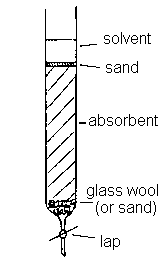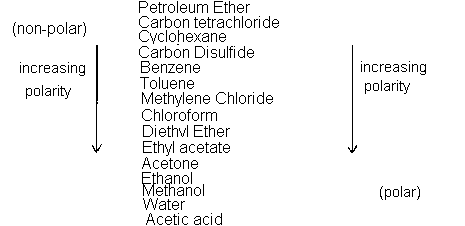
| McMaster University - Chem2O06 Lab Manual | 1997/98 |
Experiment 2. TLC of Analgesic Drugs - Introduction
General Principles of Chromatography
Chromatography is a technique which is widely used to separate a mixture of substances into its component parts.
The term chromatography encompasses a number of different techniques which, although they will be discussed separately, are all based on common principles. Chromatography
may be divided broadly into three kinds: adsorption, partition and ion-exchange, and the simplesttype of these is adsorption chromatography. In this technique, the substance under investigation is adsorbed onto a solid support (the stationary phase), such as alumina (aluminum oxide) or silica gel (oxides of silicon), and separation of a mixture into the component parts is achieved by elution with solvents of different polarity. Adsorption chromatography may be carried out in two
ways, by column, or thin layer techniques, and these will be discussed separately. In this experiment you will use the thin layer technique but a brief discussion of the column technique is included for additionl background. In column chromatography a finely divided adsorbent such as silica or alumina is placed in a glass column, supported at the bottom by a wad of glass wool, as shown below:

A layer of sand is placed over the top of the adsorbent, and the whole column is wetted with the solvent to be used. A solution of the substance to be purified in this solvent is then applied evenly to the top of the column, and this solution is allowed to pass down into the column so that the dissolved solid is adsorbed at the top of the column. The column is then eluted by passing down number of solvents of increasing polarity. In this way, weakly adsorbed substances will pass rapidly through the column while the more strongly adsorbed substances will pass through at a slower rate. By eluting with a series of solvents of increasing polarity it is therefore possible to separate the components of a mixture and to elute them, one after the other, from the solid adsorbent.
The order in which the compounds are eluted will depend on how strongly they are adsorbed on the surface of the stationary phase. Alumina unless specially pretreated is slightly basic and hence strongly adsorbs acidic substances or materials capable of forming hydrogen bonds to the basic oxygen atoms of the alumina. Compounds without the ability to form hydrogen bonds but with substantial dipole moments will be somewhat less strongly adsorbed due to electronic interactions between their dipoles and those of the alumina. Compounds with neither acidic hydrogens nor dipole moments are only very weakly adsorbed due to dipoleinduced dipole interactions.
The choice of solvents used to elute the various components of the mixture from the column will depend upon the components in the mixture. For a very weakly adsorbed component a very nonpolar solvent such as petroleum ether or benzene would be used. For more strongly adsorbed components, a more polar solvent such as ether might be used. For very strongly adsorbed components, a very polar solvent such as ethanol, water or even acetic acid might be required to displace the material from the column. A list of common solvents in order of increasing elutive power follows.

Thin layer chromatography is another type of adsorption chromatography. Here, the solid adsorbent, again usually alumina or silica gel, is spread out in a thin layer over a glass or plastic sheet, and the substance under examination is placed on this layer in the form of a spot. A suitable solvent is then allowed to run up the sheet by capillary action, as shown below:

where,
x = distance (in cm) from origin to solvent front
y = distance (in cm) from origin to the sample spot (since, if too much sample had been applied, the spot is very large, and its centre varies with its size, y is usually
measured to the front of the sample spot.
During the elution with the solvent, the sample will partition itself between the stationary phase (the adsorbent layer) and the moving phase (the solvent) so that the distance which the sample moves up the plate is characteristic of that substance and will differ from one substance to the next. The distance moved by the spot of sample divided by the distance moved by the solvent is known as the Rf value and is characteristic of that compound for the solvent system used. A mixture of substances will thus give rise to a series of spots, one corresponding to each component. This technique is extremely useful for analysis on a micro scale and for the purification of small quantitites (usually less than 0.1 g) of material. In preparative work, a substance is recovered from the plate after development by removing the particular region of the adsorbent layer containing that substance from the plate, followed by the removal of the substance from the adsorbent layer by extraction with a suitable solvent.
The second general type of chromatography is partition chromatography, the three major types here being gasliquid chromatography, liquidliquid chromatography and paper chromatography, which is an application of liquidliquid chromatography. In the first two cases, the stationary phase commonly consists of a liquid which is bonded to an inert solid substance. For liquid chromatography, eluting the system with a moving liquid leads to separation of the components of a mixture by the partitioning of these components between the stationary and moving liquid phases so that the components will move at differing rates through the column. Separation is thus achieved by collecting the moving liquid phase in different fractions as it leaves the column. In gas chromatography (see Experiment 4), however, the moving phase is a stream of an inert gas, such as nitrogen or argon. The sample under investigation is volatilised and the vapour swept through a column of the stationary phase by the carrier gas. Partition of the sample between the stationary and moving phases will occur. The sample may be recovered from the gas as it leaves the column by condensing it at a low temperature. Paper chromatography is analogous to thin layer chromatography except that in this case, the support material consists of a sheet of specially prepared paper, and the stationary phase is considered to be water adsorbed on the paper. Elution with a solvent, measurement of the Rf value and preparative work is carried out in the same way as for thin layer chromatography.
The third type of chromatography, ionexchange chromatography, is of somewhat more limited application. Here, the solid support consists of a resin which can have either basic or acidic properties, and mixtures of acidic or basic substances can be separated using these resins by eluting with buffers of different pH's.
Criteria of Purity
Solids
A very useful criterion of purity for a solid substance is the sharpness of its melting point (see Experiment 1). A solid substance which contains only 1 or 2% of an impurity will melt slowly over a wide range of temperature, say 104112 oC, whereas the pure substance will melt sharply at a characteristic temperature, e.g., 1134 oC. The melting point of a substance is characteristic of that substance. The lowering of a melting point by the presence of an impurity is a phenomenon which may be explained by a consideration of the nature of the melting process. The melting point of a solid is the temperature at which the solid and liquid are in equilibrium, that is, the temperature at which the crystal structure of the solid breaks down, giving way to a random organization of the molecules in the liquid phase. This crystal structure is weakened by the presence of even very small amounts of a different material an impurity and so the temperature at which it breaks down is reduced.
However, an alternative criterion is its chromatographic behaviour. A pure compound should give only one spot on a TLC plate , or only one peak on a chromatogram (be that GLC, LC, or HPLC).
Liquids
Nowadays, the best and most commonly used criterion for the purity of a liquid is gas chromatography. Again, this technique can be used to establish that a liquid consists of a single, pure component and with modern instrumentation it is possible to detect impurities of less than 0.1%. In the absence of this technique, however, physical measurements such as boiling point, density and refractive index may be used.
As will be evident from the discussion of distillation (pp. 31 to 310), if a liquid is pure it will boil at a constant temperature which will not vary during its distillation, and this test of purity is frequently applied to liquids. As the boiling point of a liquid is very dependent on atmospheric pressure, it is usual to quote this value when boiling points are recorded, for example, a boiling point of 142 oC/744 mm. The measurement of density and refractive index, and comparison of these values with known standards, can also be useful as a test for the purity of a liquid.
Characterizaton
Having obtained a sample of an organic material in a pure state and established its purity by applying the methods listed above, the next step in the identification of a substance is to determine its physical properties, as below:
For a solid: Solids are always characterized by quoting melting point, optical rotation (if applicable), chromatographic behaviour, and spectroscopic properties.
For a liquid: Liquids are characterized by quoting boiling point, refractive index, density, optical rotation (if applicable), chromatographic behaviour and spectroscopic properties.
An essential part of the characterization of any compound which has not been previously reported in the chemical literature, is a determination of its molecular formula. This is normally performed in two stages, firstly a determination of the empirical formula (the ratio of atoms present) by a combustion analysis. Thus, for example, a compound might be found to contain 60% carbon, 8% hydrogen and 32% oxygen. This gives the empirical formula as C5H8O2. A determination of the molecular weight as 300 would then give the molecular formula, i.e., that of the complete molecule, as C15H24O6. Once a compound has been characterized in the above manner and the value of its physical properties recorded in the chemical literature, it will always be possible to identify the substance, should it be encountered again, by reference to these values.
The determination of the structure of a compound, once it has been obtained in a pure state and characterized, is a subject which is beyond the scope of this review. A variety of physical and chemical methods is available, but all depend initially on having obtained a pure sample of material and this remains one of the most important facets of organic chemistry.
| Go to: | Instructions for Printing this Document Experiment 2 - Main Page Part A Procedures Part B Procedures Chem2O06 Home Page. |
16sep97; wjl